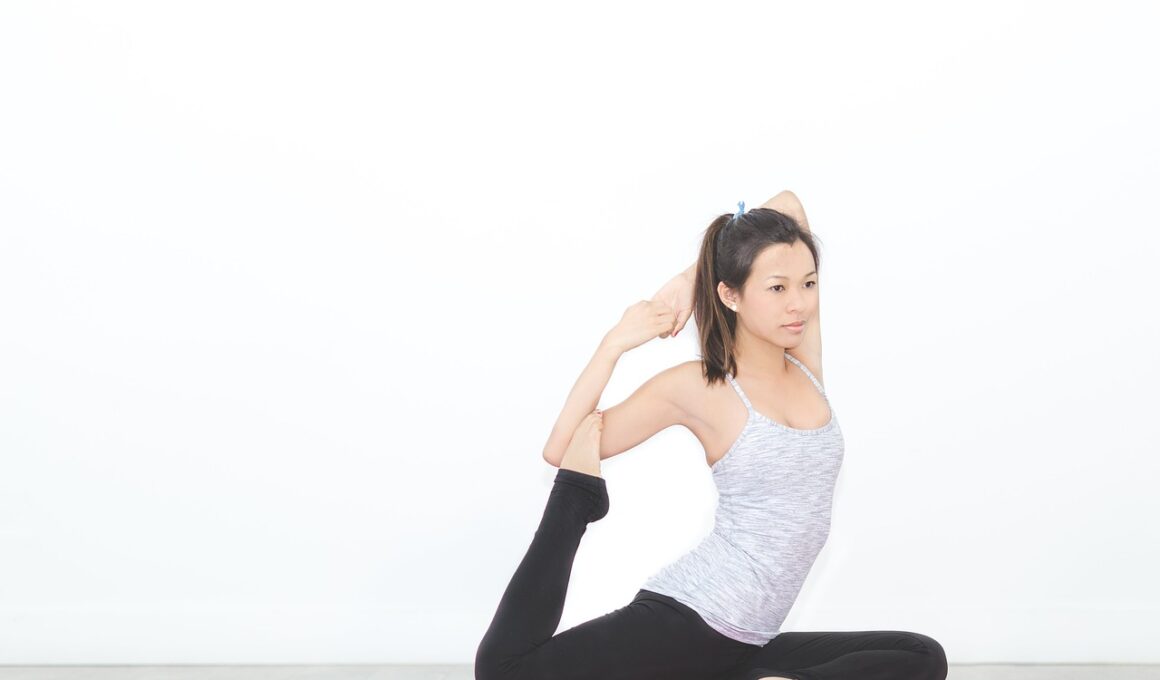Stretching Routines to Enhance Mobility in Chronic Disease
Stretching routines tailored for individuals experiencing chronic diseases can greatly enhance mobility and overall physical health. These routines are essential as they not only promote flexibility but also help alleviate stiffness and discomfort associated with various chronic conditions. Engaging in a regular stretching regimen can lead to improved circulation and muscle function. It’s crucial to start slowly, focusing on deep breathing and gentle movements. Warm-up before stretching to prevent injury and remember to listen to your body. Some beneficial stretches include neck rolls, shoulder stretches, and gentle torso twists, all of which can assist in easing tension. Stretching should be a gradual process, and maintaining consistency is key. Aim for a minimum of 15 minutes daily, breaking your session into short intervals to avoid fatigue. As you build your strength and endurance, gradually introduce more challenging stretches. Connecting with a certified physical therapist specializing in chronic illness can provide personalized routines tailored to your specific needs. Always consult your healthcare provider before beginning any new exercise or stretching program, ensuring it aligns with your medical condition.
Benefits of Stretching for Mobility
The benefits of stretching extend far beyond merely enhancing flexibility for those with chronic diseases. Improved mobility is vital for maintaining independence and performing daily activities. Regular stretching can reduce muscle tension, decrease pain levels, and enhance posture, which can be particularly beneficial for individuals with conditions like arthritis or fibromyalgia. Improved blood circulation resulting from stretching routines may facilitate the delivery of essential nutrients and oxygen throughout the body. This can assist in the recovery of muscles, resulting in less fatigue after engaging in activities. Furthermore, stretching routines can contribute to mental health by promoting relaxation and reducing stress levels, which is particularly important when managing chronic conditions. As individuals become more attuned to their bodies, they may develop a better understanding of their limits, leading to a more effective and enjoyable exercise experience. Incorporating mindfulness techniques during stretching, such as focusing on breath patterns, may enhance the overall benefits. It’s essential to integrate stretching into a holistic approach to health that includes proper nutrition, hydration, and rest for optimal results.
Incorporating dynamic stretching into your regular exercise routine aids in enhancing mobility. Dynamic stretches are active movements where joints and muscles move through a full range of motion. Unlike static stretching, which should be reserved for after workouts, dynamic stretches are recommended before physical activities. They prepare muscles for performance and reduce the chance of injury. Some effective dynamic stretches include leg swings, arm circles, and walking lunges. These movements warm up the body and improve balance and coordination, especially crucial for those managing chronic illnesses. Gradually increase the range of motion and intensity as your body’s flexibility improves. It’s also important to tailor the dynamic stretching routine based on individual capabilities and limitations, emphasizing gradual progression rather than forcing movement. Including variations ensures a comprehensive approach and engages various muscle groups, potentially leading to better overall stability and mobility. Engaging a fitness professional to design an individualized program would be beneficial. Focusing on functional movements, rather than just traditional stretches, allows for a practical approach often translating to improved daily life activities.
Regular consistency is critical when establishing any exercise regimen, including stretching methods. Aim to incorporate stretching at least three to four times per week to achieve lasting results. Setting aside designated times for stretching can help ingrain the practice into your routine, making it more likely to become a consistent habit. Utilize visual reminders, like scheduled calendar events or post-it notes placed prominently around your home, to encourage you to stick to your routine. Gradually increase the duration and intensity as your comfort level increases. Consider pairing stretching sessions with another enjoyable activity such as listening to music or practicing meditation. This can enhance motivation and make the sessions more enjoyable. Additionally, engaging with local fitness or chronic illness support groups can offer valuable encouragement and accountability. These communities often create a supportive environment where individuals share their experiences and techniques, leading to employee motivation and inspiration. Tracking progress in a journal can assist in recognizing personal achievements, helping to maintain consistency over time and adjust the routine as necessary, ensuring continuous improvement.
Simple Stretching Techniques to Try
There are several simple stretching techniques that are particularly effective for enhancing mobility in individuals with chronic diseases. One fundamental stretch is the seated forward bend, which gently stretches the back and hamstrings. Begin by sitting with extended legs and reaching your arms forward toward your toes. Hold the position for 15 to 30 seconds while breathing deeply, allowing the muscles to relax. The butterfly stretch is another excellent choice, promoting hip flexibility. Sit up tall with your feet together, allowing the knees to drop outwards, and gently push down on your knees for a deeper stretch. Lastly, the wall chest stretch is beneficial for counteracting the effects of prolonged sitting. Stand with your side to a wall, reach your arm out, and gently press against the wall, promoting flexibility in the shoulders and chest. Consistency in practicing these stretches can result in significant improvements over time. Be mindful to perform each stretch at a comfortable level, gradually increasing intensity as flexibility improves, thus ensuring safety and effectiveness in your stretching routine.
Integrated into a full exercise plan, stretching routines should be complemented with strength training and cardiovascular activities. Strength training aids muscle stabilization which eases movements and reduces tension. Resistance bands or light weights can assist individuals who may struggle with heavier lifting and should be adapted to each person’s abilities. Meanwhile, aerobic exercises can improve heart health and endurance, benefiting physical capacity. Engaging in low-impact aerobics such as walking, swimming, or cycling is often best for individuals with chronic diseases. These activities ensure minimal stress on joints. Aim for at least 150 minutes of moderate-intensity aerobic exercise weekly. Balancing these activities with stretching helps develop a well-rounded fitness plan, crucial for managing chronic diseases effectively. Health professionals can help design a plan that incorporates these elements, ensuring it fits an individual’s unique circumstances. Regularly revisiting and adjusting the plan as fitness levels change ensures continuous progress over time. Combining these elements offers a holistic approach to fitness that can enhance overall quality of life for individuals living with chronic diseases. Always consult professionals to ensure safety.
As the focus on chronic disease management grows, stretching routines remain an essential component of comprehensive care. Engaging with health professionals for personalized advice ensures individuals receive the most beneficial techniques suited to their specific conditions. Utilizing resources such as physical therapists, online classes, and community gymnastics can provide valuable guidance. Regular participation in these activities fosters community support, enhancing motivation. Awareness of one’s limitations remains important, with adjustments made based on daily fluctuations in symptoms. Supporting mental well-being through stretching routines enriches the address of chronic illness and encourages resilience. It’s crucial to celebrate small victories throughout the progress journey, instilling a sense of achievement. The importance of cultivating patience and consistency cannot be overstated; flexibility develops over time. Integration of stretching practices into everyday life enhances not only physical mobility but also emotional fortitude. Individuals should remember that every body is different, and adjusting approaches fosters a sense of individuality in their plans. Ultimately, with dedication and support, stretching routines significantly contribute to improved mobility and quality of life for those living with chronic diseases.


